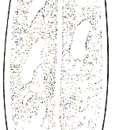Comprehensive Description
provided by Smithsonian Contributions to Zoology
Dendrocoelum komareki (Stankovi)
Neodendrocoelum sp. 2 Stankovi, 1955a, pl. 5: fig. 6.
Neodendrocoelum komarkei Stankovi, 1969:421.
Dendrocoelum (Neodendrocoelum) komareki.—Gourbault, 1972:67.
Dendrocoelum komareki.—Kenk, 1974:17.
I had in my collections no specimens that I could assign to this species. Stankovi (1969:421) himself was hesitant in describing it as a new species. The following data are excerpted from Stankovi's description.
EXTERNAL FEATURES (Figure 17).—The body size is 11–13 mm by 3 mm. The frontal margin is slightly convex, without distinct lateral lobes. The dorsal surface is brown, with a lighter median band and a pair of longitudinal rows of 5–6 unbranched light spots of different sizes. The distance of the two eyes from each other is about one-third the width of the head. The movements of the animal are slow. When it is at rest, the lateral body margins are smooth and unruffled.
ANATOMY.—The adhesive organ is weak, similar to that of Dendrocoelum sanctinaumi. The subepidermal musculature is feeble. The tubal bursae of the oviducts are less developed than in other species of Lake Ohrid. The testes are numerous, dorsal and ventral, their zone extending to the posterior end. The copulatory apparatus (Figure 39) is similar to that of D. sanctinaumi. The penis bulb is muscular, the penis papilla very long and reaching to the gonopore when extended, its distal part resembling an inversible pseudoflagellum. The common oviduct opens into the posterior part of the male atrium. The bursal duct bends to the left of the penis and opens with a slightly widened terminal portion into the small common atrium. The adenodactyl is smaller than the penis. The modified epidermis surrounding the gonopore seems to be less distinctly developed than in D. sanctinaumi.
DISTRIBUTION AND ECOLOGY.—Stankovi obtained only a few specimens of Dendrocoelum komareki from the sublittoral of the lake near the mouth of a small tributary, Daljanska, west of the town of Ohrid.
TAXONOMIC POSITION.—Dendrocoelum komareki differs externally from other pigmented species of Dendrocoelum by the color design of the dorsal surface; it differs anatomically chiefly by the very long penis papilla.
- bibliographic citation
- Kenk, Roman. 1978. "The planarians (Turbellaria, Tricladida Paludicola) of Lake Ohrid in Macedonia." Smithsonian Contributions to Zoology. 1-56. https://doi.org/10.5479/si.00810282.280

